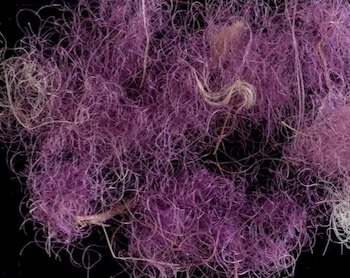It is produced from species of mollusc found in the Mediterranean, more than 180 miles from Timna.Dr Naama Sukenik, curator of organic finds at the Israel Antiquities Authority, said: “This is a very exciting and important discovery. This is the first piece of textile ever found from the time of David and Solomon that is dyed with the prestigious purple dye. In antiquity, purple attire was associated with the nobility, with priests, and, of course, with royalty. The gorgeous shade of the purple, the fact that it does not fade and the difficulty in producing the dye, which is found in minute quantities in the body of molluscs, all made it the most highly-valued of the dyes, which often cost more than gold. Until the current discovery, we had only encountered mollusc-shell waste and potsherds with patches of dye, which provided evidence of the purple industry in the Iron Age. Now, for the first time, we have direct evidence of the dyed fabrics themselves, preserved for some 3,000 years.”
Professor Erez Ben-Yosef, from Tel Aviv University’s archaeology department, said: “Our archaeological expedition has been excavating continuously at Timna since 2013. As a result of the region’s extremely dry climate, we are also able to recover organic materials such as textile, cords and leather from the Iron Age, from the time of David and Solomon, providing us with a unique glimpse into life in biblical times.”
According to the study published in the PLOS One journal, true purple (argaman) was produced from three species of mollusk indigenous to the Mediterranean Sea – the Banded Dye-Murex (Hexaplex trunculus), the Spiny Dye-Murex (Bolinus brandaris) and the Red-Mouthed Rock-Shell (Stramonita haemastoma).The dye was produced from a gland located within the body of the mollusc by means of a complex chemical process that lasted several days.
According to researchers, Timna was a production centre for copper, the Iron Age equivalent of modern-day oil.
Copper smelting required advanced expert understanding that was a guarded secret and those who held this knowledge were considered the hi-tech experts of the time.
Slaves’ Hill is the largest copper-smelting site in the valley and it is filled with piles of industrial waste such as slag from the smelting furnaces.
One of these heaps yielded three scraps of coloured cloth, which immediately attracted the attention of researchers who found it hard to believe they had found true purple from such an ancient period.
Prof Ben-Yosef added, “Archaeologists are looking for King David’s palace. However, David may not have expressed his wealth in splendid buildings, but with objects more suited to a nomadic heritage such as textiles and artefacts.”
(Press Association. Picture Courtesy: Dafna Gazit, Israel Antiquities Authority)
(Visited 284 times, 1 visits today)













